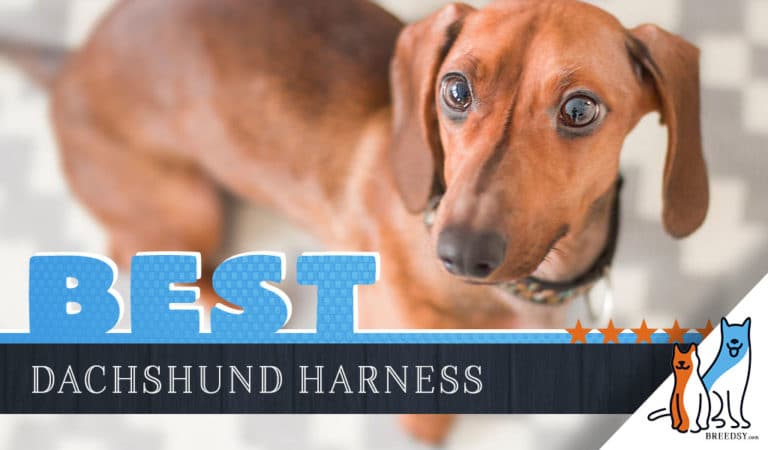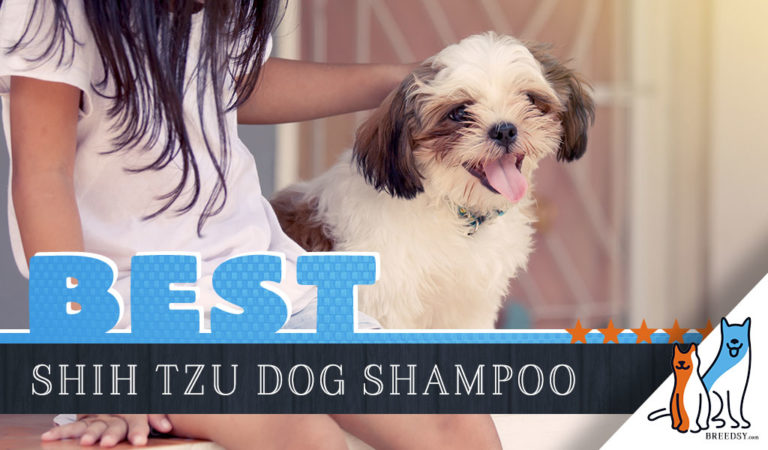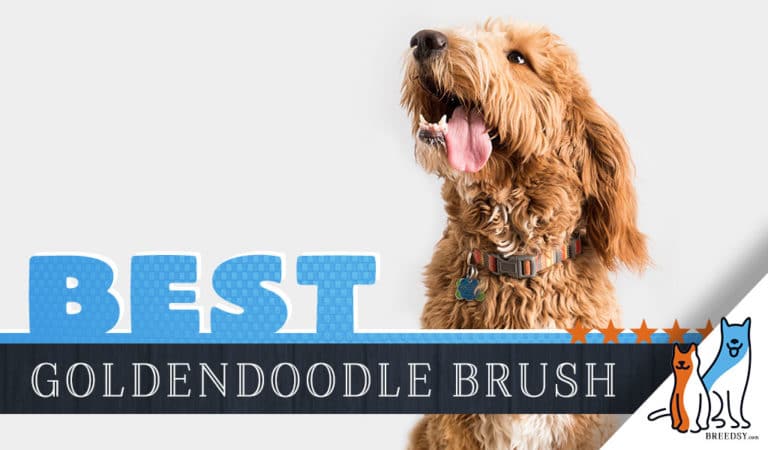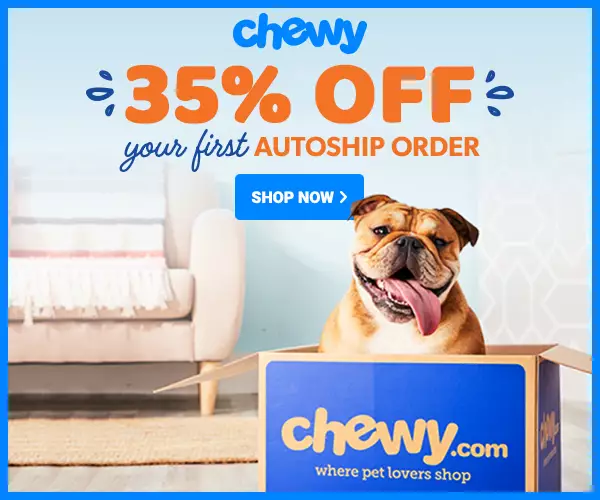8 Best Dog Harnesses for Bloodhounds in 2023
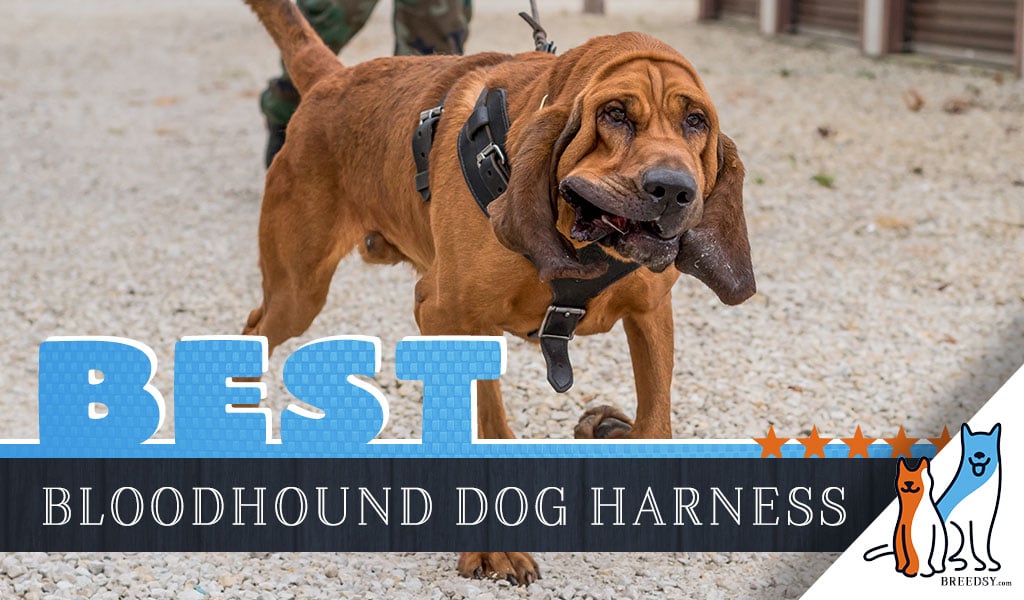
Contents
- What Is the Best Dog Harness for a Bloodhound?
- Different Types of Dog Harnesses for Bloodhounds
- How Do I Ensure the Best Fit for My Bloodhound?
- Overall Best Dog Harness for Bloodhounds
- 6 More Highly Rated Dog Harnesses for Bloodhounds
- Best Harness for a Bloodhound Puppy
- Tips for Getting Your Bloodhound Accustomed to Using a Harness
- Frequently Asked Questions
- Conclusion
These dogs can follow the scent of humans over long distances and periods of time – and that means if they’re not on a leash, they could very easily outrun their pet owners. Being so fast and enthusiastic, bloodhounds require a strong leash that’s also comfortable for maximum efficiency.
Try to keep in mind the size of a bloodhound as well the dog’s personality type when searching for the best harness. Male bloodhounds range from 25-32 inches in height and 90 to 130 pounds in weight, with females ranging slightly smaller.
While they are enthusiastic runners and sniffers, bloodhounds tend to be mild in spirit and patient when it comes to doing their detective work. On the other hand, they can be independent and stubborn at times.
Keeping their temperament in mind, we’re going to review the seven best dog harnesses for bloodhounds, and one for puppies, and explain why their special qualities require a specific type of harness. Let’s begin!
What Is the Best Dog Harness for a Bloodhound?
Different Types of Dog Harnesses for Bloodhounds
Harnesses are a better option to collars since Bloodhounds tend to pull the leash frequently, which can easily choke them on a tight collar. Not only is a harness recommended, but a harness is meant for a dog that “shoots” out fast, eager to run or sniff. Harnesses give you more control and can even guide the dog to go in the direction you want.
There are four types of harnesses:
H-shape Harness: The H-shaped harness fits snugly in two circular parts, one by the neck and bust of the dog and the other over the trunk or midsection. The hook goes by the trunk. With this harness style, your dog can move its shoulder blades and elbows normally, even when struggling, but without any major pain.
T-shape Harness: The T-shape harness is the more freeing option since it’s easy to put on and doesn’t hinder your dog’s movements very much. Its design is in contrast to the H-shape, which more easily guides your dog in the direction you want it to go.
Y-shape Harness: The Y-shape harness is more controlling than the H-shape since the fastener goes under the dog’s chest rather than above the back. That means that if the bloodhound suddenly jumps to run, it will feel uncomfortable and feel inclined to slow down. Y-shape harnesses are also called “training” harnesses.
There is also an X-shaped harness sold online, but this is highly discouraged for bloodhounds because they discharge tension on a restricted point of pressure under the neck and shoulder blades, which causes joint pain.
How Do I Ensure the Best Fit for My Bloodhound?
The bloodhound’s independent spirit and determination to follow a scent will give your dog the drive to run away fast and make its own decisions. Meaning Droopy might sometimes zone out when it comes to obeying orders.
That means you should expect plenty of pulls on the harness, even if you’re just going out for a walk!
First, make sure the harness fits your dog’s unique body shape, as a puppy or as an adult. Choosing the right size is a matter of measuring various areas on its body, including:
- Girth (Circumference of the ribcage, behind the front legs to the back)
- Lower neck (Thickest part of the neck, right on top of the shoulders)
- Chest width (If applicable, across the chest and breastbone to just behind the legs)
You can read more about measuring dogs and fitting harnesses here.
Make sure the soft measuring tape is snug and not too loose or too tight. You might also consider the weight of the dog to determine the difference between small, medium, or large.
Go by the manufacturer’s suggestions for weight and or measurements, which are usually organized by categories of:
- Extra Small (10 inches neck, 15 inches girth)
- Small (15 inches neck, 20 inches girth)
- Medium (20 inches neck, 25 inches girth)
- Large (25 inches neck, 30 inches girth)
- Extra Large (30 inches neck, 40 inches girth)
Overall Best Dog Harness for Bloodhounds
| Our 2023 Picks: Bloodhound Harness Recommendations | |||
| Rank | Dog Harness | Price | Rating |
|
#1 |
 |
$$ |
A
|
|
#2 |
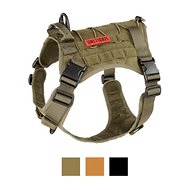 |
$ |
A+
|
|
#3 |
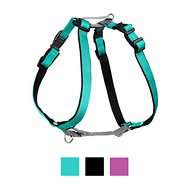 |
$ |
A+
|
|
#4 |
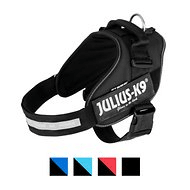 |
$$ |
A+
|
|
#5 |
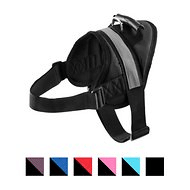 |
$ |
A+
|
|
#6 |
 |
$ |
A
|
|
#7 |
 |
$ |
A
|
|
#8 |
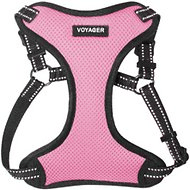 |
$ |
A
|
Learn more about our top harness choice for your bloodhound.
EzyDog Convert Dog Harness
If your bloodhound pulls frequently, consider choosing the EzyDog Convert Dog Harness. The EzyDog Convert design is sturdy and durable. Best of all, it’s comfortable for the dog and doesn’t pinch the neck whenever there’s a pull or lunges out.
It’s easy to apply, right over the dog’s head, and then around the chest. It fits snugly while also having a back loop handle for better control and restraint over sudden movements. The exterior polyester is tough and protects against wear, while the cotton lining underneath ensures comfort.
Customization features include removable fastener side labels and packs for extra storage. The EzyDog Convert harness is our top pick because any pet owner, from beginner to pro, can use it for training or walking thanks to its Original Shock Absorbing Leash technology and easy strapless function.
6 More Highly Rated Dog Harnesses for Bloodhounds
OneTigris Tactical Service Vest Dog Harness
The OneTigris Tactical harness is waterproof, which is significant since bloodhounds drool all the time. This tactical harness is made from nylon on the outer shell, making it heavy and tough, but with soft interior padding.
The Modular Lightweight Load-carrying Equipment webbing on the side allows for storing pouches. The V-ring leash attachment and control loop near the front can help discourage pulling. Adjust the neck and chest straps to get an appropriate fit. If you want to walk your bloodhound on trails and sidewalks, the tactical design of this harness is ideal for control.
PetSafe 3-in-1 Dog Harness
For extra big dogs, including adult bloodhounds, try a front-clip harness. The 3-in-1 concept of PetSafe’s harness helps with adjustability in three parts; the front, back, and even with driving safety restraints.
Front-clip style design won’t even work for smaller dogs or even bloodhound puppies because the leash will tangle. The strap padding is lined with neoprene, which makes the harness easy to wear even past the hour mark. Five points of adjustability help with fit and pulling.
Julius-K9 IDC Powerharness
The Julius-K9 IDC has such a precise designed law, it’s the preferred choice by law enforcement for service dogs and rescue dogs. The skin-friendly Eco-Tex liner is very soft and breathable, while the buckles are break-resistant and weatherproof. They will survive in cold temperatures or even wet rafting adventures.
The Julius-K9 IDC borrows from Y and H design structures and has the shape of a Y but with a link on the bust for extra support. The handle on top lets you keep your bloodhound steady and controlled, even at a short distance.
HDP Big Dog No Pull Dog Harness
The HDP No Pull harness is unique and the opposite of many other leashes, specifically because it’s gentle to older bloodhounds that require gentler handling. The no-choke design makes it easy to control the dog even if it hard-pulls away, but with a comfortable feeling for senior dogs.
The wider chest piece more evenly distributes the weight shifts from the chest to the shoulders, creating a softer walking experience. The extra padding in the harness keeps the dog pampered, while the D-ring provides better freedom of motion.
Lead Dog Harness
The Harness Lead Dog Harness is a more aesthetic choice at first glance, because of the strap-friendly design. The construction, however, reduces uncomfortable pulling and allows for easy leading, all the while remaining very lightweight.
The material softly tightens the dog’s torso when they pull away and relaxes as soon as they stop. This reduces pulling because it trains your bloodhound to seek out the gentler feeling.
The harness-lead combination of this particular product (and its lack of buckles) lets you put it under coats and sweaters for an easier fit compared to thicker harnesses.
Industrial Puppy Emotional Support Dog Harness & Leash Set
The Fair Housing/Air Carrier Access Act protects pet owners that suffer from emotional or behavioral disabilities. Industrial Puppy’s Emotional Support Harness is designed for “every occasion” and is both comfortable and visually striking.
Let others know this is a working dog, an emotional companion, not a “pet”, with removable patches for ID and labels, whether at work or play. The mesh lining and double-stitched nylon ensure long-term durability, while the clip-on backpacks or saddlebags are unique to the brand.
Best Harness for a Bloodhound Puppy
Best Pet Supplies Voyager Step-In Mesh Dog Harness
When choosing a harness for a puppy, you’re looking for a snug fit for a rounder and generally slender body shape, not to mention smaller. Harnesses not designed for puppies or smaller dogs will chafe or choke the neck area since puppies tend to pull away even more than do adult dogs.
The Voyager harness has comfortable padding, which protects the chest area, excellent for bloodhound puppies, who will be recklessly tracking and pulling.
The step-in top-friendly mechanism eliminates much of the hassle of a traditional harness, so you won’t have to wrestle with the pup to get it inside the harness for a click. Simply let the puppy step into the harness and fasten it from the top. The mesh material is all-weather for all seasons, breathable, and able to withstand heat or cold temperatures.
Tips for Getting Your Bloodhound Accustomed to Using a Harness
Now that you know some of the best harnesses by brand, it’s time to discuss the game plan! Here are seven tips that might help familiarize your bloodhound with a harness and leash.
1. Start Inside
Get your dog used to the collar and harness combination while inside the house. Ease your pet into the lifestyle change over time. Play games so he/she knows this is not a punishment, but a fun encounter.
2. Teach First, Guide Second
Teach your bloodhound a cue, associating the new rule with something positive, like a treat. Sound cues work best, as in making a distinct sound and then giving a treat. They will learn to anticipate the treat upon hearing the sound and follow the new rule by default.
3. Teach to “Come Here”
Next, make your bloodhound come to you. When he or she approaches you naturally, back up a few steps and encourage a move forward. Give a reward for the extra effort. Keep doing this until your dog learns the formula of: hear the cue, come to you, walk alongside you, then get a treat.
4. Take It Outside (Slowly)
Start slow when you go outside for the first time. Watch closely and if the dog is about to lunge, use the verbal cue and then step away. End the exercise early, building anticipation for the next walk.
5. Keep Things Fun
Bloodhounds must learn to associate all walking and guiding as a pleasant experience, one about treats and new experiences. If the dog starts to pull away, stand still, become firm and resolute. The dog yanks itself around but you should not.
For more suggestions on leash and harnessing techniques, please visit the American Kennel Club’s resources.
Frequently Asked Questions
Is It True That Bloodhound Puppies Have More Problems With No-Pull Harnesses Than Other Breeds?
Bloodhound puppies take considerable time in maturing, all the way up to two years, according to some sources. When they’re young, they’re clumsy, curious and fearless.
Rather than think of a “no pull” harness as a permanent fix, it’s better to spend more time training a bloodhound puppy early on with verbal cues and treats. Give your dog plenty of exercise during puppyhood to wear out its enthusiasm.
When you sense that your dog picks up on a new smell and is itching to go chase it, stand firmly. The dog will eventually give up. Don’t fight against its puppy instincts. Instead try to guide them towards proper channels.
Do Head Halter Harnesses Cause Problems?
While it seems logical to pull a bloodhound’s face away from the ground since the nose leads the dog, head halters (or the muzzle-type leashes) don’t work very well.
The bloodhound’s droopy face tends to get in the way of a tight collar. Some bloodhound owners also notice problems with choke chains and prongs because the jowls easily get caught in the leash.
My Bloodhound Still Won’t Seem to Cooperate Even After Trying All These Tips and Harnesses! What Am I Missing?
Harnesses are a means to redirect, not stifle the bloodhound’s natural urge to go on an adventure. The point bloodhound owners often miss is that all bloodhounds should be given off-leash time as a reward. Allow your dog to sniff to its heart’s content, track, and wander some of the time.
Choose a trail that’s safe and where you can easily follow your dog. In the beginning, try to use a longer leash to let it feel free. Short leashes are for walking in public, long line leashes should communicate to your bloodhound that is time for free-roaming.
Conclusion
Remember, manufacturers do base these big dog harnesses on the design of “tracking harnesses”, made for law enforcement dogs, such as bloodhounds. The harnesses we covered received favorable reviews for their design, durability, and control features.
Pay attention to the measurements and ease your dog into the harness slowly and patiently. You will have an obedient super-sniffer in no time!



